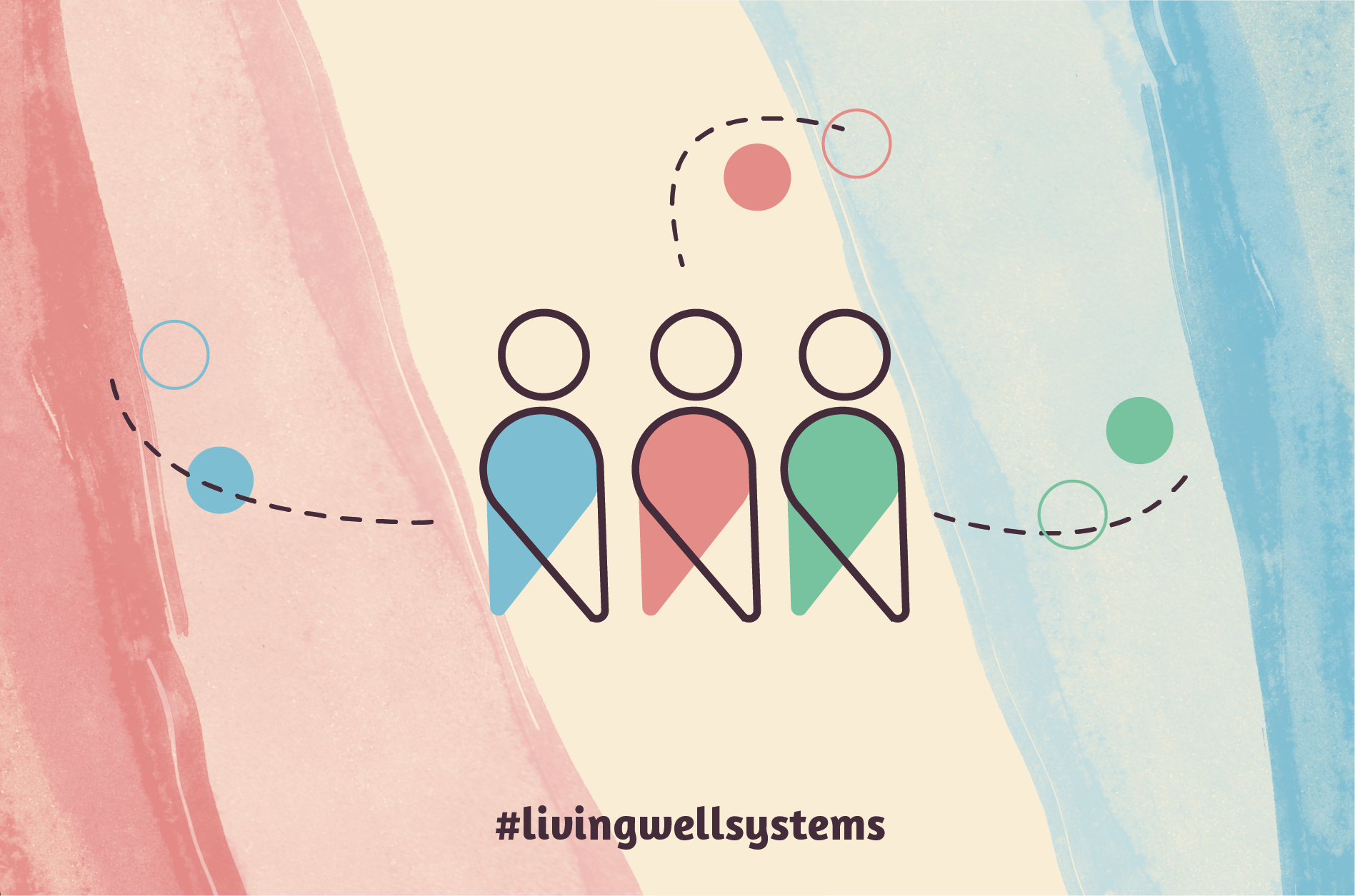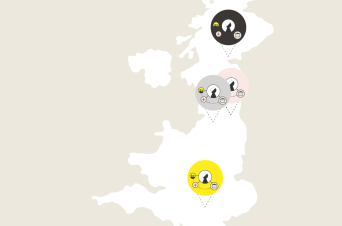
False choices and gaps in the mental health system
blog | Words Matthew Horne | 08 May 2019
Matthew Horne, Deputy Chief Executive at Innovation Unit, explains why we need new systems of support that help people to live well.
Over the last 6 months our Living Well team at Innovation Unit have visited half a dozen local mental health systems in England and Wales. It has been a privilege to see, hear and learn from brilliant people doing seriously difficult work with limited resources. Perhaps the most inspiring stories we have heard are those of people recovering from mental illness, emotional distress and trauma, who all want to help create a system that is better.
This blog introduces a set of false choices and gaps in the current system which drive how services are delivered. It uses stories of people we met to show how the system is failing and introduces four local Living Well systems of support we are working with through Living Well UK, a three-year programme funded by the National Lottery Community Fund.
WHAT WE LEARNED ABOUT THE CURRENT MENTAL HEALTH SYSTEM
The system is full of brilliant people. We met mental health practitioners who are full of care, compassion and resilience, committed to doing a difficult job well, and leaders and managers looking for new and better ways of delivering services for the people with the greatest need. We met volunteers and staff in the voluntary sector who provide social, emotional and psychological help as well as practical support to people in distress. And we met clinicians committed to evidence based practice who take responsibility for what can be life saving decisions. Most important of all, we listened to the stories of people with lived experience of mental and emotional distress, mental illness, and trauma. Some were upsetting, many were full of hope, but each individual we met wanted the mental health system to be better; better next time they need it and better for the next person who walks through the door asking for help.
These brilliant people are seriously stretched. They are stretched by the demand for their services: demand that is relentless, rising and complex. And they are stretched by the budgets they have available: budgets that are either being cut, frozen or growing slower than the costs of delivery. The ambition has been set to achieve parity with physical health services, but it remains an ambition, not a reality. Mental health is an under resourced system.
More money is desperately needed, but will not be enough. More money will not solve the problems in the mental health system or drastically improve the mental health outcomes of our population. The only way we can achieve a widespread shift in outcomes is if we tackle some very big systemic problems with the way mental health services are designed, organised and delivered.
FALSE CHOICES AND GAPS IN THE CURRENT SYSTEM
Our team came up with this shortlist of what is wrong with the current system:
Three false choices
- Mental illness vs mental health
- Medical needs vs social needs
- Assessing eligibility vs providing help now
Three gaps in the system
- Between primary and secondary care
- Between the statutory and voluntary sector
- Between children’s and adult’s mental health services
False choice 1: Mental illness vs mental health
The system is not a mental health system, it is a mental illness system.
Sam is currently emotionally and mentally distressed. She says that she wants to hurt herself and has thought about ending her life. She has had her benefits stopped and is at risk of eviction. She is not sleeping well, drinks heavily, is neglecting herself and can get angry very quickly. Sam also experienced significant trauma in her life when she was abused as a child. But Sam is unlikely to receive help and care from specialist mental health services – her distress is not thought to be part of an underlying life long mental illness such as depression, and her history of trauma doesn’t guarantee her eligibility for specialist help.
If Sam continues using alcohol to help her live with the trauma in her life, she could lose her home and become more vulnerable. She may go onto develop a diagnosable mental illness and receive a diagnosis. By which time her life has deteriorated and months or years have been lost.
Sam needs some help now to prevent her situation getting much worse, but the system is set up to diagnose and treat mental illness, not prevent illness or build stronger mental health.
False choice 2: Medical needs vs social needs
Our mental health is greatly affected by our social circumstances and social relationships.
Tom cares for his wife Patricia who has alzheimers. They own their own home, but because he is unable to work they live off their small amount of savings and income from benefits. Tom’s wife doesn’t recognise him anymore which is painful for Tom, and although they live together he feels lonely. He worries about leaving Patricia and so doesn’t go out much or see any of his friends. He has become very withdrawn and low, and is scared of what will happen to his wife if he has to go into hospital or if he dies before her.
Tom’s situation shows how social circumstances – family life, loneliness, income insecurity – impact on our emotional and mental health. These impacts can happen to people from all backgrounds and are often amplified by physical illness.
Our NHS is not geared up to respond to these social issues: medical services are designed to diagnose and treat physical and mental conditions with evidence based interventions. Many clinicians rightly point out that their skills and training doesn’t equip them to address these issues and often the NHS refers people to charities who can help with housing, debt, finding work, loneliness. Here many people find care, compassion, and practical help from skilled workers, but these charitable services are poorly and insecurely funded, staff are poorly paid, and there is very little integration with health or social care services.
False choice 3: Assessing eligibility vs providing help now
At times it seems as though mental health services provide more assessment of need than help with need.
Back to Sam, who was assessed by her GP and referred to talking therapies. Sam waited 10 months for therapy, but was then sent back to her GP because her current situation was too unstable to start therapy. Sam was referred to the community mental health team and waited for three weeks to be assessed again. Here she did not meet the threshold for secondary care so was again sent back to her GP. Her GP has told Sam that if she does harm herself or feels very unwell she should go straight to A&E where she will be seen by the liaison service who will assess her again. They may well spend an hour with her, offer her a follow up appointment the next day, refer her to the community mental health team, or put her in touch with a charity.
Sam appears to be on a merry go round of services that are all assessing risk and need in different ways. Sam wants help but she does not fit the criteria or tick enough boxes to get access to what she needs. This system of gatekeeping, thresholds, eligibility, referrals, contacts and assessments is an industry designed to make it hard to get access to services, for fear that the service will be overwhelmed and the quality of what it provides will be compromised. In this system countless hours of valuable staff time and skill are absorbed in processes that ultimately don’t help Sam very much.
THREE GAPS IN THE SYSTEM
These false choices result in three dangerous gaps in the mental health system.
Gap 1: Between primary and secondary care
Increasing levels of demand and increasing levels of complexity of need result in people bouncing between GPs, talking therapy services, CHMTs, adult social care and A&E. People present in primary care with mental health needs and social needs that cannot be readily addressed in a 10 minute GP appointment. GPs who feel they do not have the skills or time to help, refer to secondary care. But many people don’t fit neatly into the service boxes that the secondary care system has created. So they get bounced around like a pinball. When access is denied, so they go round again.
Gap 2: Between the statutory and voluntary sector
There are some places in the UK where the voluntary and statutory sectors work closely, collaboratively and on an equal footing. But there are still too many places where investment, resource and power are weighted heavily in favour of statutory provision. This is a problem because the voluntary sector often have to live with short term funding that ends even when a local evidence base of effectiveness has been built up. In addition, clinicians tend to enjoy higher professional status and authority (eg when making mental health assessments) compared to their voluntary sector peers, who often struggle to get the people they work with the statutory support they need.
Gap 3: Between children’s and adult’s mental health services
The transition from child to adult services is very poor, and contributes to deteriorating mental health in young adulthood. Many young people who have accessed care and support as a teenager disappear from the system when they enter adulthood only to reappear when they are older, and sadly all too often they are even more unwell.
WHAT KIND OF NEW SYSTEM DO WE NEED?
Through Living Well UK, a new programme funded by the National Lottery Community Fund, Innovation Unit is working with four pioneering places to scale an approach inspired by a model developed in Lambeth, South London.
We are helping to build “Living Well systems” of support that put people’s strengths and lived experience at the centre and are designed to help people recover and stay well as part of their community.
Living Well systems of support are distinguishable by a set of key features. They prioritise working systemically in the following ways:
- Outcomes: Are accountable for people centred outcomes that promote choice, recovery and citizenship
- Voice: Put the voice of lived experience at the centre of services and the system
- Access: Provide timely access to help support when and where it is needed
- Strengths: Work holistically, building up and on people’s strengths
- Citizens: See people as citizens within communities, rather than ‘patients’ or ‘professionals’
- Networks: Activate supportive social networks in the community
- Collaboration: Work collaboratively and flatten hierarchies
- Learning: Have permission to test and learn together
PIONEERING PLACES
The places we are supporting are committed to closing the gaps in the current system, and putting an end to the false choices between a medical and social model, between mental illness and mental distress, and between controlling access and providing help now.
Luton is ‘reimagining mental health’ by co-designing new rapid access offers that help resolve distress in people’s lives. This work aligns with existing plans to test and enhance more effective support in community and primary care for working age adults who need help with mental health, substance misuse and long-term conditions. Luton CCG is coordinating the work locally.
Salford want to co-design new interventions for people with complex social and mental health needs who fall through the gap between primary and secondary care. Some of the people they want to help include: local residents who have experienced trauma in childhood, people experiencing or at risk of crisis, people struggling with housing, money and physical health issues, and those with poor mental health but not necessarily a diagnosis. Salford CCG is coordinating the work locally.
Tameside and Glossop are currently prototyping Living Life Well, a new system-wide approach to mental health that ensures people never ‘fall through the gaps’. The new approach provides a single integrated front door to mental health that offers medical, clinical and wider social support. People will own their support and recovery plan, ensuring their story is placed at the centre of assessment and planning.
Edinburgh has an ambitious whole city plan for Mental Health called Thrive Edinburgh. This includes establishing open access Thrive teams providing person centred planning; timely access to help and support; closing the gap between primary and secondary care; and providing brief medical and social support from a mixed team of voluntary and statutory sector staff.
We are inspired by the work of these pioneering places and will share more of their journey as it develops. We are also drawing on learning from examples of Living Well systems that have been developed within the UK and beyond, including the Lambeth Living Well Network which exhibits all of the features above. You can read more about them in the case studies on our website.
For more information on the Living Well UK programme and how you can connect with this practice and the learning from the evaluation, please contact Nick Webb.

Living Well UK programme announced
PRESS RELEASE: New Living Well UK programme will take innovative approach to improving mental health to four new areas thanks to £3.4 million in National Lottery funding.
20 Sep 18

Adult mental health
In Lambeth they have seized the opportunity to transform the mental health care system.
05 Jul 18

From Finland to Torbay — 3 Inspirational Mental Health Innovations
Three examples of great innovations that are inspiring and we believe can make a real difference to mental health outcomes for everyone.
13 Feb 17